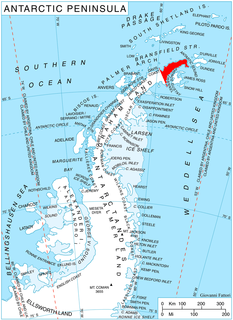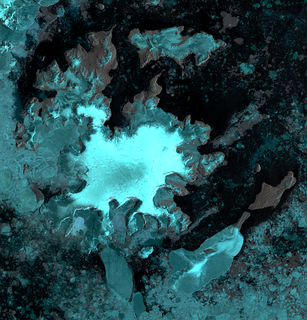
Bear Island or Isla Teniente González is a rocky island lying 1.9 kilometres (1 nmi) west of Stonington Island in Marguerite Bay, off the coast of Graham Land. Bear Island was presumably known to the British Graham Land Expedition (BGLE) (1934-1937) and the United States Antarctic Service (USAS) Expedition (1939-1941), both based in the Stonington Island area. Bear Island was surveyed in 1947 by the Falkland Islands Dependencies Survey (FIDS), who named it for the USS Bear, flagship of the United States Antarctic Service (USAS) Expedition which visited this area in 1940.

Coronation Island is the largest of the South Orkney Islands, 25 nautical miles (46 km) long and from 3 to 8 nautical miles wide. The island extends in a general east-west direction, is mainly ice-covered and comprises numerous bays, glaciers and peaks, the highest rising to 1,265 metres (4,150 ft).

The Dion Islands are a group of small islands and rocks lying in the northern part of Marguerite Bay, 11 kilometres (6 nmi) south-west of Cape Alexandra, Adelaide Island, off the west coast of the Antarctic Peninsula. They were discovered by the French Antarctic Expedition, 1908–10, and named by Jean-Baptiste Charcot for the Marquis Jules-Albert de Dion, who donated three motor sledges and whose De Dion-Bouton works produced equipment for the expedition.
Puffball Islands is a scattered group of small, low, mainly ice-covered islands and rocks which extend about 10 nautical miles (18 km) in a NE-SW direction, lying in southern Marguerite Bay off the west coast of Antarctic Peninsula. The center of the group lies 23 nautical miles (43 km) north-northeast of Cape Jeremy. First visited and surveyed in 1948 by the Falkland Islands Dependencies Survey (FIDS). The name, applied by FIDS, derives from association with Mushroom Island which lies 14 nautical miles (26 km) northeast of this group.

Laws Glacier is a confluent glacier system which flows into Marshall Bay on the south coast of Coronation Island, in the South Orkney Islands off Antarctica. It was surveyed in 1948–49 by the Falkland Islands Dependencies Survey (FIDS), and was named by the UK Antarctic Place-Names Committee for Richard M. Laws of the FIDS, leader and biologist at Signy Research Station in 1948 and 1949, and at South Georgia in 1951.

Andrew Glacier is a glacier 3 nautical miles (6 km) long, flowing northeast into Ognen Cove in Charcot Bay immediately west of the Webster Peaks on Trinity Peninsula, northern Graham Land. It was charted in 1948 by the Falkland Islands Dependencies Survey (FIDS) who named the feature for Dr. James Darby Andrew, medical officer at the FIDS Hope Bay station in 1946–47.
Noble Rocks is a group of about 19 small, low rocks in Marguerite Bay, lying east of Jester Rock in the Dion Islands. The Dion Islands were first sighted and roughly charted in 1909 by the FrAE. Noble Rocks were surveyed in 1949 by the Falkland Islands Dependencies Survey (FIDS), and so named by the United Kingdom Antarctic Place-Names Committee (UK-APC) because of their association with Emperor Island.
Norseman Point is an easternmost point of Neny Island, lying in Marguerite Bay off the west coast of Graham Land. First surveyed in 1936 by the British Graham Land Expedition (BGLE) under Rymill. Named by the Falkland Islands Dependencies Survey (FIDS) after the Norseman airplane which landed near the point to relieve the FIDS party on Stonington Island in February 1950.
Stipple Rocks is a compact group of more than twenty rocks, lying 3 nautical miles (6 km) northwest of Millerand Island in Marguerite Bay, off the west coast of Graham Land. First surveyed in 1936 by the British Graham Land Expedition (BGLE) under Rymill, and resurveyed in 1949 by the Falkland Islands Dependencies Survey (FIDS). The name, applied by FIDS, is descriptive of the representation on a map of the numerous rocks in this group.
Store Point is a northernmost point of Neny Island, lying in Marguerite Bay off the west coast of Graham Land. Surveyed in 1947 by the Falkland Islands Dependencies Survey (FIDS), who so named it because FIDS maintained an emergency food store on this point.
Stride Peak is a peak rising to 675 m at the head of Dalgliesh Bay, Porquoi Pas Island, in Marguerite Bay. Named by United Kingdom Antarctic Place-Names Committee (UK-APC) in 1979 after Geoffrey A. Stride (1927–58), Falkland Islands Dependencies Survey (FIDS) diesel mechanic, Horseshoe Island, 1958, who, with S.E. Black and D. Statham, was lost between Dion Islands and Horseshoe Island in May 1958, in a breakup of the sea ice.

Pipkin Rock is a small ice-free island, lying northeast of Dismal Island in the Faure Islands, Marguerite Bay. The Faure Islands were discovered and first charted in 1909 by the French Antarctic Expedition under Charcot. The group was surveyed in 1949 by Falkland Islands Dependencies Survey (FIDS) and so named from the insignificant size of the feature.

Pod Rocks is a small compact group of rocks, lying 9.3 kilometres (5 nmi) west of Millerand Island in Marguerite Bay, off the west coast of Graham Land. First roughly surveyed in 1936 by the British Graham Land Expedition (BGLE) under Rymill. The rocks were visited and resurveyed in 1949 by the Falkland Islands Dependencies Survey (FIDS), who established a sealing camp there. The name, proposed by FIDS, derives from the old sealers' term "pod," meaning a group of seals hauled ashore.
Felsite Island is a rock island 1 nautical mile (2 km) long and 300 metres (1,000 ft) high, lying at the head of Edisto Inlet within the northward stream of Edisto Glacier. It was named by the New Zealand Geological Survey Antarctic Expedition, 1957–58, as descriptive of several prominent dikes of cream-colored igneous rocks (felsite) in its otherwise dark sedimentary rock formation.

Mondor Glacier is a glacier 3.5 nautical miles (6 km) long flowing southwest from the head of Depot Glacier into Duse Bay, Trinity Peninsula, Antarctica. This glacier and Depot Glacier together fill the depression between Hope Bay and Duse Bay which marks the northern limit of Tabarin Peninsula. The glacier was mapped in 1946 and 1956 by the Falkland Islands Dependencies Survey (FIDS), who named the feature in association with Tabarin Peninsula. "Operation Tabarin" was derived from the "Bal Tabarin" in Paris. In Recueil General des Oeuvres et Fantaisies de Tabarin, Tabarin was the buffoon who attracted the crowd to the booth where Mondor sold his quack medicines.

Tait Glacier is a glacier about 4 nautical miles (7 km) long on the southwest coast of James Ross Island, flowing southwest into Carlsson Bay. Probably first seen by Dr. Otto Nordenskjold in 1903. Surveyed by Falkland Islands Dependencies Survey (FIDS) in 1945. Named by United Kingdom Antarctic Place-Names Committee (UK-APC) for Murdo F. Tait, FIDS meteorological observer at Hope Bay in 1952 and 1953.
Matheson Glacier is a glacier 11 nautical miles (20 km) long, lying 2 nautical miles (4 km) south of Ashton Glacier, which it parallels, and flowing in an easterly direction to the west side of Lehrke Inlet, on the east coast of Palmer Land, Antarctica. It was first sighted by members of the United States Antarctic Service who explored this coast by land and from the air in December 1940, and was first charted by a joint party consisting of members of the Ronne Antarctic Research Expedition and Falkland Islands Dependencies Survey (FIDS) in 1947. The glacier was named by the FIDS for J. Matheson, a member of the FIDS at the Port Lockroy and Hope Bay bases, 1944–46.
Rymill Coast is that portion of the west coast of Antarctic Peninsula between Cape Jeremy and Buttress Nunataks. It runs northward from English Coast and east of Alexander Island across George VI Sound. It is joined in the north by Fallieres Coast, which runs along Marguerite Bay. It was named by the United Kingdom Antarctic Place-Names Committee (UK-APC) in 1985 after John Riddoch Rymill (1905–68), Australian leader of the BGLE, 1934-37.

Randall Rocks is a group of rocks situated 1 kilometre (0.5 nmi) off the southwest corner of Miller and Island and trending in a NW-SE direction for 2 kilometres (1 nmi), lying in Marguerite Bay off the west coast of Graham Land. The group was first surveyed in 1936 by the British Graham Land Expedition (BGLE) under Rymill. It was resurveyed in 1948-49 by the Falkland Islands Dependencies Survey (FIDS) and named for Terence M. Randall, FIDS radio operator at Stonington Island, 1947-49.

Kenney Glacier is a glacier 1 nmi long flowing northwest from The Pyramid and The Saddlestone into Depot Glacier, near the head of Hope Bay, Trinity Peninsula, Antarctica. It was mapped in 1945 and 1948 by the Falkland Islands Dependencies Survey (FIDS), was resurveyed by the FIDS in 1955, and was named for Richard Kenney, assistant surveyor at Hope Bay in 1954 and 1955, who made a detailed local survey of the area between Hope Bay and Duse Bay.








